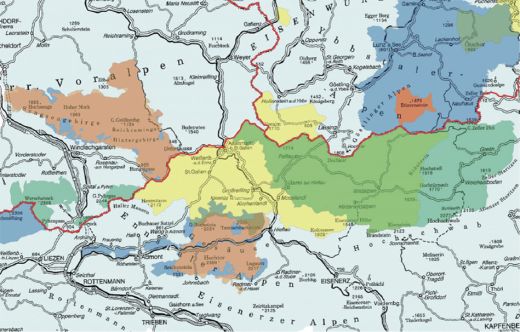“Kalkalpen National Park - promoting wilderness as a core topic”
Comment by Erich Mayrhofer, director of the Kalkalpen National Park
The Northern Kalkalpen
nature, culture and protected-area tourism
International conventions, such as the “Agreement for Biological Diversity” or the “Alps Convention”, focus on the cooperation and connectivity of conservation areas within the framework of ecological networks.
A hotspot in the Alps lies in the northern Kalkalpen and combines 15 protected areas of differing categories comprising more than 2,000 square kilometres.
The networking takes place within the “ECONNECT” initiative and the project was realised in such spheres as the reintroduction of the Ural owl and habitat protection for the white-backed woodpecker. The exchange of specialised information and communication between the seven pilot regions of the Alps takes place with the aid of the Ecological Association platform and the Alpine Network of Protected Areas (Alparc).
The potential of nature between the Kalkalpen National Park, Gesäuse and the Dürrenstein wilderness area (Rotwald) offers undreamed-of opportunities for cooperation and networking combined with regional added value.

llustration ECONNECT “Northern Kalkalpen” pilot region
The Kalkalpen National Park
The Kalkalpen National Park was founded in 1997 and with a size of 209km² it has a share in the European network of protected areas (Natura 2000). It is a central part of Austria’s natural heritage and especially of the province of Upper Austria. It is orientated on the:
- guidelines of the International Union for Conservation of Nature and Natural Resources (IUCN), for the
- mutual aims of the Austrian National Parks and the
- general legal conditions.
The long-term vision of the Kalkalpen National Park is to protect dynamic wilderness, habitats rich in flora and fauna and cultivated landscapes close to nature over a period of generations.
The medium-term aim is:
- to create a protected area in which
- the course of natural development is permanently assured
- to make 75% of the national park area, which is 156km², wilderness territory.
In the medium-term, the management aims for the National Park have been laid down in the 3rd Business Concept for the National Park for 2008-2012 and were realised according to the following plans and milestones:
|
Plan
|
Summarised planned aim
|
Medium-term business aims
|
|
Wilderness
|
Wilderness shows how nature really is! Old stands and remains of primeval forests are the core of the KNP. Together with natural procedures they are the motor of an undreamed-of diversity of species and habitats.
|
1. NP enlargement
2. Ecological Association
3. 75% wilderness
12. Wilderness definition
|
|
Biodiversity
|
Biodiversity is the most essential basis of human livelihood. To maintain this, the KNP is occupied with the overall observation of all living species of flora and fauna in their genetic and habitat diversity.
|
5. Islands of biodiversity
|
|
Species
|
The KNP is “rich in species” that through special protection or through targeted measures should have their habitats maintained or re-established.
|
4. Protection concepts
6. Support of the numbers of lynx
|
|
Monitoring
|
Natural development in the NP is permanently assured. The 209km² of the NP serves as an example and comparative area for the way in which unused nature and landscape develops. Knowledge concerning development has been won through constant observation (monitoring).
|
7. inventories in the bio-office
8. Biotope mapping
9. Three inventories completed
10. Monitoring programmes
11. Development parameters
13. Succession areas
|
|
Visitors
|
The people should be offered personal experiences through an insight into the continuity of nature. More understanding and respect for nature contribute to environmentally compatible activity and assurance of the basis of natural life.
|
19. Reduction of individual motorised traffic
15. 90% of visitors on 10% of area
16. Wilderness concept
14. Wilderness education programme
17. Establish overall concept
18. Competence and services
centres
23. Austrian NPs
24. International obligations
|
|
Communi-cation of knowledge
|
The collection, preparation and making available of knowledge serves to offer targeted information, development of offers and the promotion of image in respect of the ecological and economic benefits of the KNP.
|
20. NP brand and wilderness
21. NP image
22. NP regional outline agreement
25. Organisation structure
26. Multimedia and communication
27. Motivated realisation
|